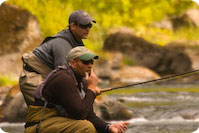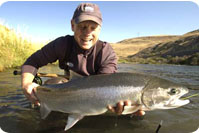When we asked the guides about Spey lines, the general consensus was about 35% of clients show up on guide trips with the wrong weight fly line for their two-handed rod. Additionally, many folks end up with a line that isnít suited well for the average conditions they face. With all of the choices out there in line styles, how do you choose whatís right for you? First, you need to decide what line style fulfills the demands of your fisheries. Letís take a close look at the strengths and weaknesses of your choices.
 Short Belly Spey Lines
Short Belly Spey Lines (50 to 60 foot weight forward head section)
Most casters will find these lines the most comfortable and versatile for a wide range of fishing applications. These lines perform at their optimum when all or most of the belly is out the rod tip prior to making the cast. If the conditions require a longer cast, the caster must shoot extra shooting line to achieve distances longer than the head length. So, if youíre fishing a line with a 50 foot belly or "head" and need to reach that boulder 60 feet out, 10 feet of shooting line will be shot into the cast during the forward stroke. The extra shooting line must be stripped in before making the next cast. With that said, beginners and experts alike will appreciate how easy these lines load the rod well even on shorter casts. For beginners, this makes learning easier. For experts, it allows for good line control in tight casting conditions.
Most of the short head lines come in a multi-tip version. With a loop to loop connection, the front 15 feet of the floating line can be replaced with one of the numerous sink-tips supplied with the line. While this gives the angler versatility, the line is limited to casting only moderate density sink-tips and medium size flies. If youíre planning on using your line for heavy sink-tip work and big heavy flies, check out the Skagit head lines.
 Long Belly Spey Lines
Long Belly Spey Lines (60 to 90 foot weight forward head section)
Many anglers like long belly lines for the incredible casting distances which can be achieved. More so, little to no stripping of extra shooting line is required for long casts. However, these lines have their disadvantages. To begin with, if the caster has 80 feet of fly line out the rod tip at the beginning of the cast, substantial back casting room is required for your D-loop or backcast. More so, casting 80 feet of line takes more energy from the caster to move. Thus, the casting stroke is longer and requires more physical effort. This can fatigue the caster over a long day of fishing. Finally, casting sink-tips on long belly lines could be labeled as "cruel and unusual punishment". Bottom line, long belly lines are great if you fish floating lines on big rivers with lots of casting room.
 Skagit Head Spey Lines
Skagit Head Spey Lines (25 to 40 foot shooting head)
Skagit heads have revolutionized sink-tip fishing with two-handed rods. They have made fishing sink-tips and heavy flies easier, more effective, and more fun. If you look at the tackle suggestions of the guides involved with this website, every one of them is using Skagit lines with their clients for sink-tip work. A Skagit head consists of a sink-tip, a short, thick diameter floating body, and a running line. (Although these lines where designed for sink-tips, some anglers are also using floating tips for surface presentations.) Most of the heads are looped to a separate running line giving the angler a choice in the material of the shooting line. (See running lines below)
The basic principal behind the Skagit head is the condensed mass of the floating body equates to easier turn over of the sink-tip and fly. More so, if the rod has the right weight fly line, the caster will feel even a fast action rod load well into the butt section of the rod. This allows for a nice, easy casting stroke with minimal effort. To cast the system, the back end of the floating body (where it loops to the running line) must be 1' to 3' outside of the rod tip before the cast is made. Typical fishing conditions require a longer cast than the overall combined length of the head and sink-tip, thus the caster must shoot line to achieve the desired distance. This line has been criticized because you need to strip in a good amount of running line to make a long cast. What these critics donít realize is by stripping in, the fly and sink-tip raise in the water column. Because the fly and sink-tip are near the surface and closer to the caster, itís easier to lift the business end out of the water for the set up of the next cast. Furthermore, itís not uncommon to have a steelhead grab the fly on the strip in. Bonus! If your fishing conditions require fishing sink-tips and big flies, do yourself a favor... Try one of these lines.
 Scandinavian Shooting Heads
Scandinavian Shooting Heads (28 to 40 foot shooting head)
Scandinavian shooting heads are the European counterpart to the US. Designed Skagit heads. However, these lines offer a more delicate presentation though donít perform well with massive flies. Like Skagit heads, "Scandi heads" are looped to a separate running line. Additionally, the short head requires shooting running line to achieve casting distances longer than the head length.
"Scandi" heads come in a variety of densities ranging from floating to super fast full sink. For steelhead, the floating heads are the most applicable although the full sink versions are becoming more popular especially in the Great Lakes. The element that separates Scandinavian heads from all other Spey lines is the leader and fly create all of the line tension which loads the rod. In other words, when the D-loop is fully formed behind the caster, the leader and fly are the only thing touching the water when the forward cast begins. With that said, this system requires a long leader typically one to two times the rod length. A good rule of thumb is the faster the rod, the longer the leader. Traditionally, these heads where cast on very fast action rods. This makes sense when you consider these lines where originally designed for Atlantic Salmon. Salmon anglers are more concerned with the middle of the river, not the softer insides where steelhead often rest. Most steelheaders prefer a little slower rod as they can expect better performance in the short game and tight casting conditions. Consequently, a shorter leader (1 x rod length) can be used as the slower action rods donít require as much line tension to load as a faster action rod. Most anglers will prefer a 10' to 14' "Poly Leader" with additional tippet over a traditional extruded leader for Scandinavian heads. The poly leader creates more load in the rod and better turnover of the fly. Furthermore, Poly leaders come in a variety of densities ranging from floating to super fast sink. While these sinking leaders are NOT a full blown sink-tip, they will get the fly 1' to 2' down in the water column.
The advantage of a Scandinavian Head is the efficiency of the stroke. If youíre doing it right, long, graceful casts are effortless. Although the learning curve is a little steeper than a short belly Spey line, ultimately the caster can make longer casts with less work in tighter casting conditions.




